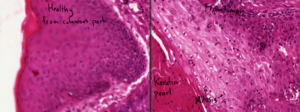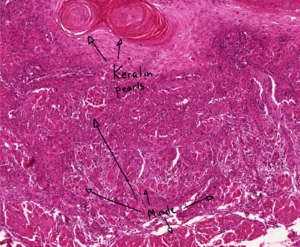36. Squamous carcinoma of lower lip

Staining: HE Organ: Lip
Description: On the right side of the slide can we see stratified squamous non-keratinizing epithelium. On the left side we can see stratified squamous keratinizing epithelium. On the top can we also see stratified squamous keratinizing epithelium, however the keratin here is very thin. On the bottom of a slide can skeletal muscle be seen.
In the middle of the slide can “pearls” of keratin be seen. On the top of the slide can a small piece of tissue be seen, and right underneath that piece is the mucosa eroded away. Tumor cells can be seen infiltrating the skeletal muscle.
Diagnosis: Well-differentiated squamous cell carcinoma

Risk factors:
- HPV
- Smoking
- Chewing tobacco
Theory:
The slide is made from a sagittal section of the lip. On the right side of the slide is the side of the lip that faces the mouth, the mucosal part. This part has stratified squamous non-keratinizing epithelium. On the left side of the slide is the cutaneous part, with stratified squamous keratinizing epithelium. The top of the slide is the red part, which is also keratinizing epithelium however the keratin here is very thin.

Normal epithelial cells don’t produce keratin inside tissues. The balls of keratin inside the tumor are called keratin pearls and are a form of abnormal keratin formation (dyskeratosis). Abnormal keratin formation usually indicates cancer. This points to that the tumor cells are epithelial cells.
The cells right next to the keratin pearls are the tumor cells. The tumor cells show mild pleomorphism and have prominent nucleoli, and we can see mitotic figures and giant cells (I couldn’t find any giant cells tho).
The loss of mucosa in the upper left corner shows ulceration, due to the malignancy of the tumor. The orbicularis oris muscle is infiltrated by cancer cells, which also shows that the tumor is malignant. This tumor is well-differentiated. The fact that the squamous cells produce keratin show that they are well-differentiated (i.e. have similar function to normal squamous cells), and because only a mild pleomorphism is seen.

